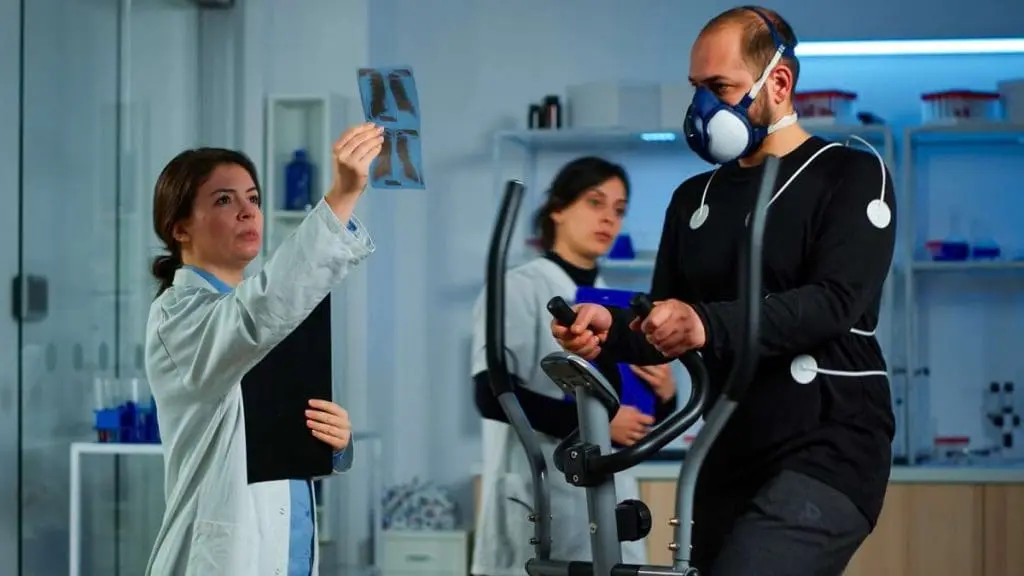Work hardening and work conditioning are both important for helping injured workers return to work and are often confused with each other, but they have subtle yet distinct differences.
For example, a work-hardening regimen is a multidisciplinary holistic program that pays attention to physical and mental well-being. Conversely, a work conditioning program focuses on restoring a patient’s physical capabilities so they can return to work and continue to perform their duties. Both approaches incorporate some of the same physical therapies, such as weight training and circuit training.
In this blog, we define work hardening and work conditioning, look at the differences between work hardening therapy and work conditioning therapy, explore the benefits of both, and dive into their primary rehabilitation goals and objectives.
Table of Contents
Understanding Work Hardening

Work hardening is an intensive, multi-week program that consists of several components designed to treat employees’ mental and physical health. A personalized work-hardening program challenges patients’ physical and mental stamina yet can help employees return to work faster and ensure their continued health and safety.
Defining Work Hardening
First developed in the 1970s, work hardening isn’t just about reconditioning a worker so that they’re physically able to perform their job. Work hardening is a highly regimented, multidisciplinary form of therapy. In addition to helping workers physically recover from injury, work hardening helps workers mentally prepare to return to work.
Work hardening therapy employs the skills of many different types of healthcare professionals. In addition to physical and occupational therapists, psychologists and vocational specialists are often involved. They work together to create customized programs for each individual, depending on their injury and physical and mental states.
Prior to beginning the program, healthcare professionals perform comprehensive physical and mental health tests on each participant. Tests can include exams to determine fine motor skills, aerobic capacity, joint flexibility, and employees’ ability to walk, climb stairs, squat, and more.
The tests create a baseline upon which future results are compared. Patients are routinely assessed throughout and at the end of the program, and results are compared to their baseline to see how much progress has been made.
A typical work hardening program lasts four to eight weeks. Sessions can be up to five days a week, and each session can last up to eight hours. Sessions consist of a combination of:
- Muscle strengthening exercises
- Spine and joint exercises
- Cardiovascular exercises
- Job simulation exercises (i.e., sitting, lifting, bending, etc.)
- Stress management
- Mental health therapy
- Speech and neurological therapy
Benefits of Work Hardening
While work hardening tends to be rigorous and demanding, it also yields many tangible and lasting benefits. A person who successfully undergoes work hardening therapy is often more physically and mentally fit for duty than they were prior to their injury. They experience decreased pain and stiffness, better muscle strength and endurance, and an overall improved quality of life.
For employers, a good work hardening program ensures that workers can return to their jobs as quickly and safely as possible. Work hardening can reduce the risk of injury and loss of labor hours. It also shows that employers care about their employees’ physical and mental well-being, which can boost employee morale and retention.
Exploring Work Conditioning

Work conditioning programs are similar to work hardening programs, but work conditioning focuses exclusively on improving the physical health of workers. Here, we look at what makes work conditioning unique and explore its many benefits.
Defining Work Conditioning
Work conditioning helps employees regain mobility, strength, motor skills, range of motion, and other physical abilities. Like work hardening, work conditioning is a specialized, vigorous, and customized form of therapy that takes place after an injury has healed.
A work conditioning program is also designed around the everyday tasks the patient normally performs at work. For example, if a patient’s job involves lifting heavy boxes, therapy sessions would simulate the lifting and placement activities the employee will have to perform upon returning to work.
Like in work hardening therapy, patients’ physical capabilities are assessed at the outset to create a baseline that can be measured as the program progresses. Treatment modifications can be made as necessary depending on how well the patient is doing.
Work conditioning programs are typically shorter in duration than work hardening therapy sessions—about two to four weeks long. Participants generally attend multi-hour sessions several days a week.
At the end of the work conditioning program, the physical therapist completes a Functional Capacity Test—a standardized test to assess the physical capabilities of the employee. If the employee passes the test, they are cleared to return to work.
Benefits of Work Conditioning
Like work hardening programs, work conditioning is tailored to each employee. That means that individuals will be able to work on specific areas of need and increase their physical capabilities to perform their unique jobs.
Employees who undergo work conditioning are often more fit for duty than before and are less likely to experience an injury. That results in a more fit employee population and minimization in the number of hours lost to injury.
Work Hardening vs Work Conditioning: Key Differences
It’s easy to see why work hardening and work conditioning programs get confused. However, though these forms of therapy are very similar, there are key differences between the two.
Program Focus and Intensity
Unlike work hardening therapy, a work conditioning program is purely focused on restoring physical functions. It is not as holistic as work hardening, nor is it multidisciplinary or involves a wide array of medical professionals. Usually, work conditioning is performed and supervised by a certified physical therapist.
Work hardening programs tend to be longer and more intensive than work conditioning programs. A typical work hardening program can last up to eight weeks and include three to five sessions per week, each several hours long. Conversely, a work conditioning program usually lasts about two to four weeks, with three to five sessions in length lasting several hours per day.
Rehabilitation Goals
The rehabilitation goals for work hardening and work conditioning therapy are very similar. The ultimate goal is to get impacted employees back to work safely. Within that goal are subgoals, including:
- Improving range of motion
- Improving strength, stability, and flexibility
- Improving mechanics (such as the proper way to lift heavy objects, proper posture, etc.)
- Increasing the employee’s awareness of how to prevent future injuries
- Improving an employee’s overall physical and mental well-being
- Decreasing the employee’s fear of going back to work
- Preventing a recurrence of the injury that the employee was being treated for
Work Hardening vs Work Conditioning: FAQ

What is Work Hardening?
Work hardening is a multidisciplinary form of therapy that companies use to help injured employees return to work. A work hardening program includes a combination of physical and mental health therapy. Work hardening therapy typically involves a wide range of medical professionals, including physical therapists, occupational therapists, psychologists, and vocational health specialists.
Work hardening therapy is highly regimented and intensive. A typical program consists of several sessions per week and several hours per session. Particularly intensive programs can include sessions five days a week, eight hours per session.
Work hardening programs can last up to eight weeks. In the beginning, medical professionals will perform a baseline analysis of the patient’s physical and mental health. Throughout the program, periodic assessments will be performed and results will be compared to the baseline. Adjustments will be made as necessary.
Patients will engage in different exercises, including:
• Muscle strengthening exercises
• Spine and joint exercises
• Cardiovascular exercises
• Job simulation exercises (i.e., sitting, lifting, bending, etc.)
• Stress management
• Mental health therapy
• Speech and neurological therapy
At the end of the program, a comprehensive assessment is performed. Results are compared to the patient’s baseline. If favorable, the patient is cleared to return to work.
What is Work Conditioning?
A work conditioning program is a form of physical therapy that focuses on helping employees regain mobility, strength, motor skills, range of motion, and other physical abilities.
A work conditioning program is designed around the everyday tasks the patient normally performs at work. For example, if a patient’s job involves lifting heavy boxes, therapy sessions would simulate the lifting and placement activities the employee will have to perform upon returning to work.
Work conditioning programs are typically two to four weeks long. Participants generally attend multi-hour sessions several days a week. Patients are continually assessed throughout the program to ensure they are making progress toward their goals. Exercises are modified as needed.
At the end of the program, the physical therapist completes a Functional Capacity Test—a standardized test to assess the physical capabilities of the employee. If the employee passes the test, they are cleared to return to work.
What are the Goals of Work Hardening and Work Conditioning?
The ultimate rehabilitation goal for work hardening and work conditioning therapy programs is to return impacted employees to work quickly and safely. Additional goals include:
• Improving range of motion
• Improving strength, stability, and flexibility
• Improving mechanics (such as the proper way to lift heavy objects, proper posture, etc.)
• Increasing the employee’s awareness of how to prevent future injuries
• Improving an employee’s overall physical and mental well-being
• Decreasing the employee’s fear of going back to work
• Preventing a recurrence of the injury that the employee was being treated for
What is Included in a Work Hardening or Work Conditioning Baseline Assessment?
During the initial visit, a therapist will evaluate the patient’s injury and create a baseline report that can be measured as the program progresses. As part of the assessment, the therapist will:
• Determine the patient’s current physical activity level
• Ascertain the patient’s aerobic capacity
• Test the patient’s grip strength
• Test the patient’s range of motion, core and joint strength, and flexibility
• Determine the patient’s mental health state (work hardening only)
Following the initial assessment, the therapist will create a treatment plan tailored specifically to the patient’s needs. If the patient is attending a work hardening program the plan will be created in collaboration with other healthcare professionals overseeing the patient’s care, including occupational therapists, psychologists, etc.
Who Can Benefit from Work Hardening or Work Conditioning Programs?
Anyone can participate in work hardening or work conditioning therapy programs, though workers in labor-intensive fields tend to benefit the most. These include:
• Electricians
• Plumbers
• Law enforcement officers
• Firefighters
• Mechanics
• Construction workers
• Healthcare providers
• Delivery drivers
• Truck drivers
Deciphering the Right Path: Final Thoughts on Work Hardening vs. Work Conditioning

Work hardening and work conditioning programs are similar and are often confused with each other. However, each program is unique. It’s important for employers to select the right therapy to achieve specific goals.
If the goal is to simply improve the physical well-being of the patient, then a targeted work conditioning program is the optimal choice. Work conditioning is performed by a licensed physical therapist and focuses exclusively on helping employees regain and improve their physical abilities, including mobility, strength, flexibility, and range of motion.
If the goal is to improve the patient’s physical and mental health prior to returning to work, a work hardening program is a better option. Work hardening is a multidisciplinary form of therapy that focuses on both the physical and mental well-being of the patient. Work hardening therapy sessions typically involve a range of licensed healthcare professionals, including physical therapists, occupational therapists, psychologists, and vocational health specialists.
Both work conditioning and work hardening programs can last several weeks, though work conditioning programs are often shorter in total duration than work hardening programs. In either case, patients are required to attend therapy sessions several times a week, several hours per session.
Whatever program that’s chosen, the patient will ultimately be able to return to work more quickly—and more physically capable. They’ll also have a better understanding of how to prevent injuries in the future. Their companies will be able to reduce the number of hours lost to injury, thereby improving productivity and employee morale, and retention.
Acuity’s experienced team of healthcare professionals has created and managed thousands of work hardening and work conditioning programs for clients around the world. We understand what it takes to get employees back to work safely and quickly.
Learn more about Acuity’s occupational health services and connect with us.
